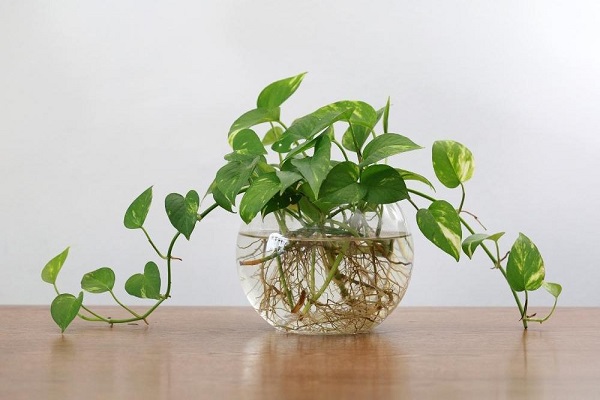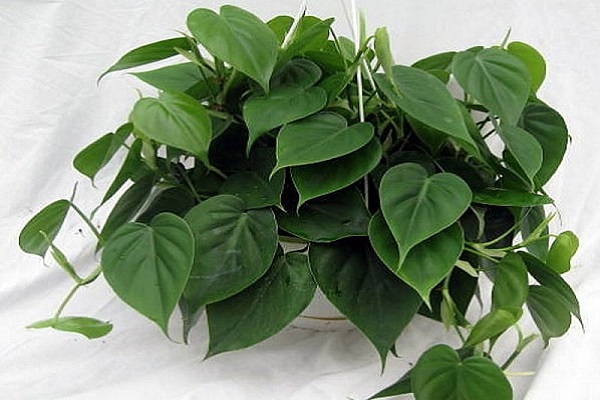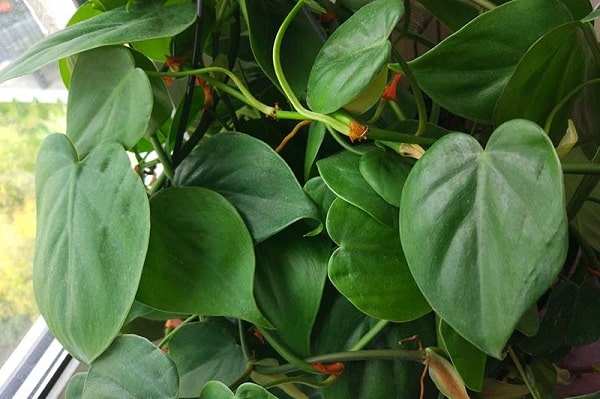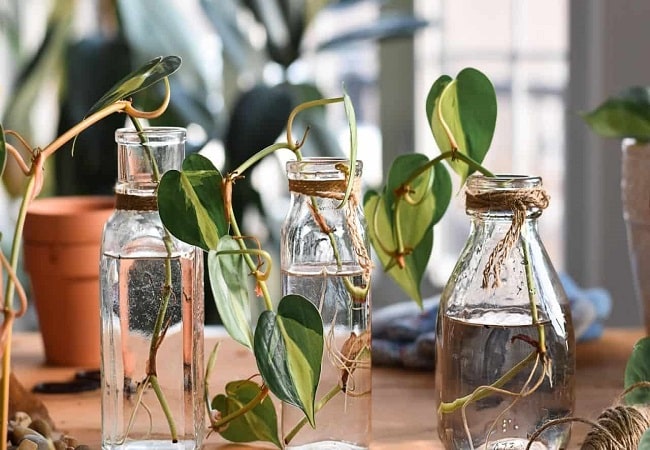The heart leaf philodendron, scientifically known as Philodendron hederaceum, is a beloved houseplant cherished by gardeners and plant enthusiasts for its lush, heart-shaped leaves and easygoing nature. This vining plant adds a touch of verdant beauty to any indoor space, making it an ideal choice for both experienced gardeners and novices alike.
In this article, we will delve into the captivating world of heart leaf philodendrons and uncover the secrets to successful propagation. Our comprehensive guide will walk you through each step of the process, enabling you to multiply your collection and bring even more greenery and life to your home or office. So, let’s embark on this journey together and learn how to propagate heart leaf philodendrons with confidence and ease!
Quick Navigation
How To Propagate Heart Leaf Philodendron

Heart leaf philodendron is a popular houseplant species you should propagate by stem cuttings or root division. The easiest way to take stem cuttings is to remove a basal stem from the plant and use a sharp knife to cut 1-2 inches below the leaves. Make sure the soil covers the bottom of the cutting so it can grow roots.
After cutting, insert it into a pot of fresh soil and water well. Keep the cutting in a warm place and wait for new roots to form before transferring it back to its original pot. Heart leaf philodendron can spread by root division. To do this, dig up an established plant and cut its roots into smaller pieces. Then, replant the pieces in fresh soil.
Heart Leaf Philodendron Growing Conditions

Heart Leaf Philodendron is a great houseplant for people who want a low-maintenance plant that is easy to care for. It grows best in bright, indirect sunlight. It tolerates a wide range of temperatures, making it a great choice for apartments or homes with few windows.
In the spring and summer, the plant has treated with a balanced fertilizer once a month and should receive frequent irrigation. It’s crucial to maintain consistent soil moisture and to refrain from overwatering. As the plant ages, the leaves will turn yellow and drop off, so it’s critical to cut them back every year or two to keep the plant’s appealing appearance.
Make A Stem Cutting Of Heart Leaf Philodendron
To propagate the heart leaf philodendron, you must make a stem cutting. To do this,
- First, find a healthy stem that is at least 6 inches long. Then, cut the stem near the base with a sharp knife or scissors.
- Next, place the stem cutting in the Soil and water it well.
- Keep an eye on it and give it regular care (watering, fertilizing, and pruning) to help it grow into a new plant.
Put The Heart Leaf Philodendron Cutting In Water
Watering a heart leaf philodendron is not difficult. Still, you should follow the proper procedure to ensure success.
- The best way to water a heart leaf philodendron is by placing it in a container of potting soil that has been moistened.
- Water the philodendron regularly, but do not over-water it. If the soil becomes dry, add water until the desired moisture level is achieved.
- Do not allow the potting soil to become too wet or dry, damaging the plant.
Getting The Cuttings To Root
To propagate heart leaf philodendron, you must take cuttings from the desired plant.
- You can either take stem cuttings or root cuttings. Make a 1-inch long horizontal slice from the stem just below the anode to take stem cuttings.
- Ensure the cutting surface is smooth and lightly dusted with rooting powder before cutting. Make another horizontal slice about 1 inch away from the first, keeping the petiole attached to the cutting.
- Make a vertical slice about 1/2 inch deep and place both slices in a glass of water with a small rock on top for weight.
- Finally, place your container in a bright location and check daily for new roots. Once new roots have developed, transfer the cutting to a pot filled with fresh Soil and water. Make a 1-inch long horizontal slice from the desired plant to take root cuttings.
Troubleshooting Heart Leaf Philodendron Care Problems

When propagating a Heart leaf philodendron, a few things can go wrong. The most common issue is that the root system fails to develop properly, resulting in the plant’s death. Root rot, over-watering, and too much fertilizer are all possible issues.
When it comes to propagating heart leaf philodendron, there are a few things that you need to take into account.
- First, ensure the plant has been properly acclimated to your home before propagating it.
- Secondly, select the correct type of rooting medium for the philodendron.
- Finally, be prepared to monitor the plant closely during propagation to ensure it doesn’t suffer any adverse effects.
Why Heart Leaf Philodendron Not Growing?
Heartleaf philodendrons are a popular houseplant because they are easy to grow and have a long life span. But, if your heartleaf philodendron is not growing, there may be some reasons why:
- Make sure that the plant has enough light and water.
- Check to see if the plant is getting enough fertilizer.
- Make sure that the plant is planted in the correct location.
If all of these things are correct, check to see if there is a problem with the root system. If the problem is with the root system, you will need to remove and replace the entire root system.
Leaves Turning Brown Or Yellow
The most common problem with heart leaf philodendron is that leaves turn brown or yellow. This is usually caused by a lack of light or too much light. If you cannot get the plant enough light, you can try using a grow light or fluorescent bulb. If the plant is getting too much light, you can try moving it to a darker spot in the room.
There are five things you can do to prevent or treat leaf spots:
- Use a fungicide when planting your philodendron; this will kill any fungus growing on the plants before it can damage them.
- During dry times, make sure to water your philodendron well. Overwatering can also cause fungal problems.
- Use a high-nitrogen fertilizer on your philodendron regularly. This will help it grow well and reduce the chance of fungal problems.
- Avoid standing water on the plants; this is a common source of fungal growth.
- Keep your philodendron in a well-ventilated area; too much humidity can lead to fungal problems.
Transplanting The New Plants
When transplanting heart leaf philodendron, you must use a suitable soil mix for the plants’ new location.
- Philodendrons are relatively hardy and can tolerate a wide range of conditions. Still, they will not perform well if transplanted into an unsuitable environment.
- Make sure the soil is well-drained and free from weeds. Use a potting mix specifically designed for growing philodendrons; do not use regular potting soil.
- Before planting in the ground, add organic matter and top dress with compost or manure. After transplanting, water the plants often for the first few weeks to keep them from drying out and to stop weeds from growing.
Root Rot
When propagating a Philodendron heart leaf, root rot is a common problem. The plant’s roots may become waterlogged and begin to decompose, causing the plant’s health to deteriorate. To avoid this,
- Make sure the Philodendron heart leaf is planted in well-draining soil and only water it when the soil is dry.
- If you see signs of root rot, like yellowing leaves or slow growth, pull up the roots and replant them in new soil.
Over-Watering
Overwatering is a common problem for heart leaf philodendrons. When the plant is constantly wet, the roots cannot get enough oxygen and begin to rot. This can cause the plant to die. To avoid this, you should water your philodendron only when the soil is dry and not overflowing.
Excessive Fertilizing
Popular indoor plants that can reach heights of several feet include heart leaf philodendrons. However, nourishing this plant properly is crucial if you want it to reproduce. Overfertilizing can cause the leaves to become thin and spidery, and the plant may not flower or produce fruit. Fertilize your philodendron only when the soil is dry, and use a diluted solution. Use a balanced fertilizer with nitrogen, potassium, and phosphorus to feed your philodendron only when the soil is dry.
Philodendron Heartleaf Plant Care & Watering Guide

Philodendron heartleaf plants are easy to grow and care for, but there are a few things that you need to keep in mind when growing this plant. First, ensure that the soil is moist but not wet. Too much moisture can cause root rot, while too little water can result in a dry and brittle plant. Secondly, give your philodendron heartleaf plants plenty of sunlight and fresh air. Finally, water your plant regularly – especially during the summer months – but don’t over-water it as this will cause root rot.
Watering Properly
Philodendrons are a type of succulents grown for their leaves and flowers. When watering your philodendron, ensure the water is distributed evenly through the soil. Do not water your philodendron from above or allow standing water to accumulate on the plant.
It is possible to propagate by dividing the roots, but you must water them regularly to keep them healthy. Water them when the soil feels dry, and then water them again when its surface begins to droop.
Fertilizing
Heart leaf philodendrons need a good fertilizing schedule to thrive. A balanced fertilizer that includes nitrogen and phosphorus will help encourage vigorous growth. Ensure you regularly water your plants and fertilize them to keep them healthy and happy.
- One way to fertilize heart leaf philodendron is to use a houseplant fertilizer.
- Another way to fertilize your heart leaf philodendron is using liquid fertilizer.
- Either way, make sure to provide the plant with nutrients regularly.
Best Light Conditions For The Heartleaf Philodendron
The heartleaf philodendron does best in bright light, although it can handle some low-light conditions. It should be placed in a location with plenty of natural light and protected from direct sun. This plant is also tolerant of humidity levels to be grown indoors or out.
Temperature For Heart Leaf Philodendrons
The ideal temperature for a heart leaf philodendron is around 70 degrees Fahrenheit. They do well in a warm, moist environment as long as the humidity remains high. The key to propagating heart leaf philodendrons is to keep the plants healthy and free of pests.
Best Soil Conditions For Heart Leaf Philodendron
Heart leaf philodendron does best in well-drained soil with a pH of 6.0-7.5. They prefer medium to moist conditions and can tolerate partial shade. These plants are propagated by root division in late winter or early spring.
Repotting Your Heart Leaf Philodendron
Repotting is an important step when it comes to propagating heart leaf philodendrons. Repotting allows the plant to grow and develop more vigorously while ensuring that the roots have plenty of space to spread out. Depending on the size of the philodendron, you may need to repot it every two or three years.
- First, to repot a heart leaf philodendron, ensure you have removed all of the old potting soil and excess fertilizer.
- Then, fill a pot one-third of the way with fresh soil and add enough water to moisten the soil.
- Gently lower your philodendron into the pot and press down lightly, so its roots are well-covered.
- Make sure there is plenty of space in the pot for the plant to grow, and water the philodendron regularly.
Humidity Levels For The Heart Leaf Philodendron
The heart leaf philodendron is a plant that thrives in a moist environment. Keeping the humidity levels high for this plant is important, as low humidity levels can cause the leaves to become brittle and die. To maintain the desired humidity level, it is best to use an air humidifier or place a damp towel on the floor near the philodendron.
Frequently Asked Questions
Can You Propagate Heart Leaf Philodendron In Water?
Yes, heart leaf philodendrons propagated in water. The easiest way to propagate them is by taking cuttings from a healthy plant and planting them in freshwater. Make sure to keep the water evenly moist and provide plenty of light.
Is It Better To Propagate A Philodendron In Water Or Soil?
There are pros and cons to propagating a philodendron in water or soil. Most of the time, growing plants in water is easier, but it’s harder to get them to grow if you don’t give them enough water. Still, you must ensure the soil is well-drained and has good aeration.
How Long Do Philodendron Cuttings Take Root In Water?
Philodendron cuttings root in water within a few days, but they may not take root quickly because they are working their way down into the soil. You can speed up the rooting process by misting the cuttings with water every day or two. Once they have rooted, you can transplant them into the soil or a pot.
How Do You Make A Philodendron Bushy?
There are a few ways to make your philodendron bushy. One way is to use a rooting hormone. Another way is to place the philodendron in indirect sunlight and water it regularly. You can also prune the branches regularly to make the plant bushy.
How Much Light Does A Heartleaf Philodendron Need?
For the Heartleaf philodendron to grow well, it needs a lot of light. At least six hours of direct sunlight should hit them every day. Because they don’t like too much water, you should keep them in a soil mix that drains well.
Conclusion
Heart leaf philodendron is a beautiful and interesting plant that various methods can propagate. From what I’ve read, I can tell that cuttings of stems are used to grow new Philodendron heart leaf plants. Additionally, they propagated by dividing the plant’s stem into sections or by taking a leaf cutting and planting it in soil. With a little care, your new heart leaf philodendron will thrive.

My name is Md Deloar Hossain and I’m the creator of Club Gardening, designed for all your gardening ideas, gardening product reviews, and a place to help you find the best gardening experience possible.


